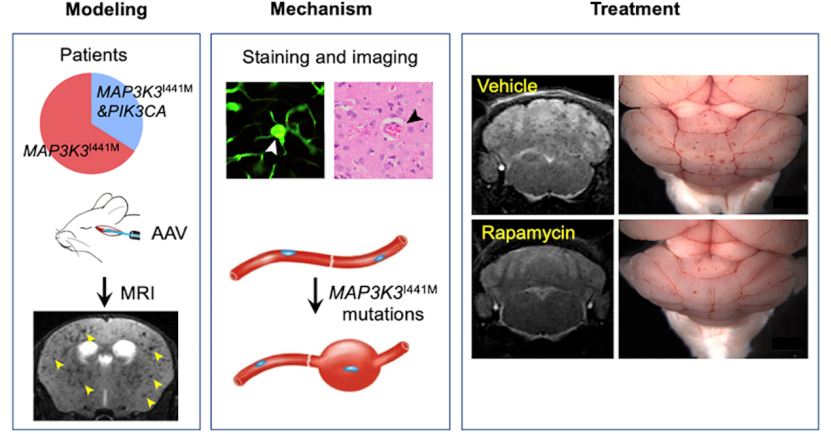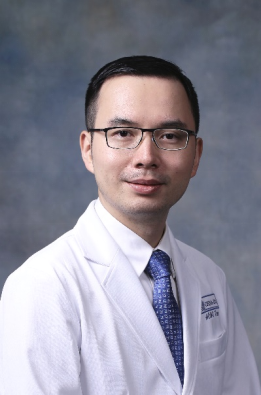Recently, the team of Professor Hong Tao of the Department of Neurosurgery at Xuanwu Hospital, Capital Medical University, in collaboration with the team of Professor Go Nao Ping of the Center for Brain Science and Brain-like Research in Beijing, published a research paper in BRAIN entitled "Somatic variants of MAP3K3 are sufficient to cause cerebral and spinal cord cavernous malformations". Based on the discovery of MAP3K3 or PIK3CA somatic mutations that cause cerebral and spinal cord cavernous malformations, the team demonstrated that single gene overexpression mutations of MAP3K3 can cause cerebral and spinal cord cavernous malformations in mice, and successfully constructed an animal model of central nervous system cavernous malformations, and provided promising therapeutic targets for patients with cerebral and spinal cord cavernous malformations. The animal model was successfully constructed and provided promising therapeutic targets for patients with cerebrospinal cavernous vascular malformations. Dr. Jian Ren of the Department of Neurosurgery, Xuanwu Hospital, Capital Medical University, Dr. Yazi Huang of the Center for Brain Science and Brain-like Research, Beijing, and Yeqing Ren, a doctoral student in the Department of Neurosurgery, Xuanwu Hospital, Capital Medical University, are co-first authors, and Professor Tao Hong and Professor Nongping Ge are co-corresponding authors.
Cavernous malformation (CM) is the second most prevalent hemorrhagic vascular anomaly in the central nervous system, and the genetic mechanism of disseminated cavernous malformation, which accounts for 85% of the disease, has been unknown. 2021, several international teams, including our team, identified MAP3K3 and PIK3CA somatic activating mutations associated with disseminated cavernous malformation (Hong, et al. However, whether MAP3K3 is the initiator of the disease and the possible molecular mechanisms leading to the disease remain unclear.
In this study, a mouse model of brain and spinal cord cavernous vascular malformation expressing MAP3K3I441M mutation was established using the endothelial-specific BR1 serotype AAV virus of the central nervous system, and a pathological phenotype similar to that of MAP3K3I441M patients was detected, and a combination of two-photon live imaging and genetic labeling methods were used to observe the MAP3K3I441M overexpression mutation endothelial cells induced the dynamic process of cerebral cavernous vascular malformation development and rupture and bleeding, and found that cavernous vascular malformation began with the expansion of mutant vascular endothelial cells and disruption of the blood-brain barrier. In addition, the team found that the application of the mTOR inhibitor rapamycin attenuated the MAP3K3I441M-induced hemorrhagic phenotype of cerebral cavernous vascular malformations in mice. This work provides important clues to the pathogenesis of sporadic cerebrospinal cavernous vascular malformations and suggests promising targets for drug therapy.

A mouse model of cavernous vascular malformation based on brain endothelium-specific MAP3K3I441M mutation to study disease mechanisms and intervention strategies
This research was supported by the National Natural Science Foundation of China under the Outstanding Young Scientists Fund and other projects (81971104, 32170964, 81971113, 82201440), and by the Beijing Center for Brain Science and Brain-like Research and other projects. The work was also supported by Prof. Yibo Wang from the National Center for Cardiovascular Diseases, Prof. Wenzhi Sun from the Beijing Center for Brain Science and Brain-like Research, and Prof. Yilong Wang from the Beijing Tiantan Hospital, Capital Medical University.

Hong Tao, Senior Consultant Neurosurgeon, Xuanwu Hospital, Capital Medical University, is an Professor and a mentor of doctoral student. He is also the Secretary General of the Expert Committee of Neurosurgery for Capacity Building and Continuing Education of National Health Care Commission, and a member of Beijing Youth Federation. He was selected for the National Natural Science Foundation of China Outstanding Young Scientists Fund, Beijing 100 Million Talents Project, Capital Medical University Young Scholars and other talent programs. He is mainly engaged in the research of surgical treatment and mechanism of cerebrovascular diseases in neurosurgery, especially the research of new mechanisms of genetic pathogenesis and new clinical features of vascular malformations. He has published 18 papers in English, including 8 in BRAIN, JAMA, Neurology and other high-impact journals, and 2 cover articles. In recent years, he has presided over 7 research projects at all levels. He has been awarded the Beijing Youth May Fourth Medal, Beijing Youth Role Model, and the Top 10 "Future Stars" of Capital Health, etc.
Any use of this site constitutes your agreement to the Terms and Conditions and Privacy Policy linked below.
A single copy of these materials may be reprinted for noncommercial personal use only. "China-INI," "chinaini.org" are trademarks of China International Neuroscience Institute.
© 2008-2021 China International Neuroscience Institute (China-INI). All rights reserved.